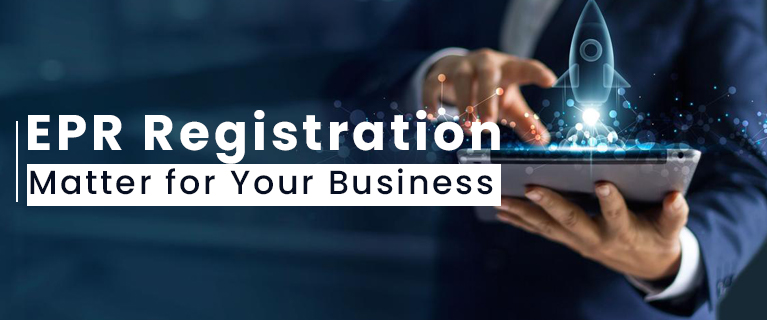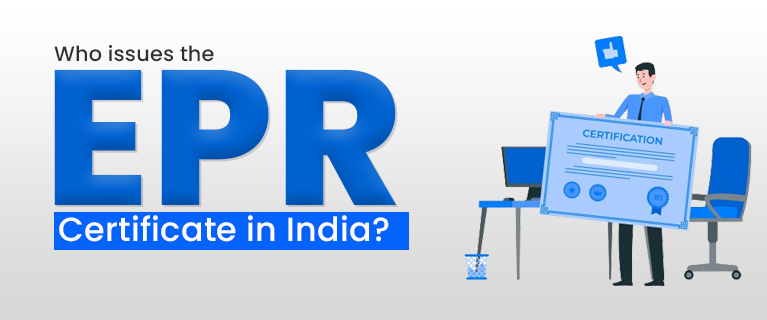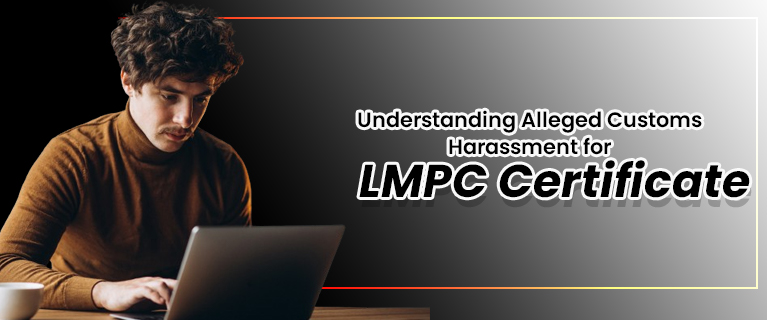Why Does EPR Registration Matter For Your Business?
In today's increasingly environmentally conscious world, businesses are under growing pressure to adopt sustainable practices and reduce their environmental footprint. One crucial step in this journey towards sustainability is obtaining Extended Producer Responsibility (EPR) registration. EPR registration is not just a regulatory requirement; it's a strategic move that can positively impact your business in several significant ways.
1. Legal Compliance and Avoiding Penalties:
EPR laws mandate that businesses take responsibility for the entire lifecycle of their products, including their eventual disposal. Failing to comply with these regulations can result in substantial fines, legal troubles, and damage to your brand's reputation. By obtaining EPR registration, your business demonstrates a commitment to fulfilling its environmental obligations, reducing the risk of non-compliance, and the associated penalties.
2. Enhancing Brand Reputation:
Consumers are increasingly making purchasing decisions based on a company's environmental responsibility. EPR registration sends a strong message to your customers that you are committed to sustainability and reducing the environmental impact of your products. This can significantly enhance your brand's reputation and attract environmentally conscious consumers, ultimately driving sales and customer loyalty.
3. Cost Savings Through Efficient Resource Management:
EPR registration encourages businesses to adopt efficient resource management practices . By reducing waste generation, reusing materials, and recycling, you can lower your operational costs. Moreover, many EPR programs involve the collection and recycling of products, potentially turning what was once waste into a valuable resource, further benefiting your bottom line.
4. Market Access and Competitive Advantage:
In some industries, EPR registration is becoming a prerequisite to access certain markets or retail chains. Without proper registration, your products may not be eligible for sale in these markets, limiting your business's growth potential. Conversely, being EPR registered can give you a competitive edge, making your products more attractive to retailers and consumers alike.
5. Contributing to a Sustainable Future:
Beyond the immediate business benefits, EPR registration allows your company to contribute to a more sustainable future. It aligns your operations with broader environmental goals and helps reduce the environmental impact of products throughout their lifecycle. By taking a proactive stance on environmental responsibility, your business becomes a part of the solution to global sustainability challenges.
Read Also This - How can I Get EPR Registration & PWM Compliance
Steps to Obtain EPR Registration:
Obtaining Extended Producer Responsibility (EPR) registration is a comprehensive process that requires careful planning, implementation, and ongoing compliance. Below, we'll delve into each step of this process in detail:
1. Understand Applicable Regulations:
Begin by thoroughly researching and understanding the EPR regulations that apply to your specific industry and location or by seeking help from the experts of LegalRaasta. EPR regulations can vary significantly, so it's crucial to identify the precise requirements and obligations that your business needs to meet.
2. Develop an EPR Plan:
Creating a comprehensive EPR plan is the cornerstone of the registration process. This plan should outline how your business will manage the environmental impact of your products throughout their lifecycle. Key components of the EPR plan include:
Product Assessment: Analyze the effects your products have on the environment and identify areas that can improve.
Design for Sustainability: Consider how product design can minimize environmental impact, such as using recyclable materials or reducing energy consumption during use.
Collection and Recycling: Develop strategies for collecting and recycling products at the end of their life. This may involve setting up collection points, collaborating with recycling facilities, or providing return options for customers.
Consumer Education: Implement initiatives to educate consumers about the importance of responsible product disposal and recycling.
3. Collection and Reporting:
Establish systems for collecting data related to the environmental impact of your products. This includes information on product materials, energy consumption, waste generation, and recycling rates. Accurate data collection is essential for monitoring and reporting your compliance with EPR regulations.
4. Compliance Assessment:
Regularly assess your business's compliance with EPR regulations. This involves evaluating whether your EPR plan is effectively reducing the environmental impact of your products. If necessary, make adjustments to your plan to enhance its effectiveness.
5. Application Submission:
Prepare and submit your EPR registration application to the relevant regulatory authorities. The application should include detailed information about your EPR plan, data on your products' environmental impact, and evidence of your compliance efforts.
6. Audits and Inspections:
Inspections and audits are conducted by the concerned authoritties to make sure that all the EPR requirements are taken care of.. During these audits, authorities may review your data collection processes, recycling efforts, and adherence to the EPR plan outlined in your application.
7. Reporting and Documentation:
Maintain thorough records of all EPR-related activities, including data collection, recycling efforts, and compliance assessments. You'll likely be required to submit periodic reports to regulatory authorities to demonstrate your continued compliance with EPR regulations.
8. Continuous Improvement:
EPR registration is an ongoing commitment to environmental responsibility. Continuously seek opportunities to improve your EPR plan and further reduce the environmental impact of your products. Stay informed about evolving regulations and adjust your practices accordingly.
By following these steps and maintaining a proactive approach to environmental responsibility, your business can successfully navigate the EPR registration process and enjoy the benefits of reduced environmental impact, enhanced reputation, and legal compliance.
Read Also This - How To Register EPR Online And Who Is Required To Do The Registration
Principles of EPR Registration
To successfully implement EPR, companies must first gain a thorough understanding of the concept and the specific EPR laws and regulations applicable in their jurisdiction.
Assessment and Planning:
Before diving into EPR compliance, companies must conduct a comprehensive assessment and create a well-thought-out plan. This involves identifying which of their products fall under EPR regulations and the associated responsibilities. Gathering data on materials used in products, product life cycles, and their environmental impact is a crucial part of this process. Setting realistic recycling and recovery targets is essential to measure progress and demonstrate compliance. Additionally, careful budget planning is required to allocate the necessary resources for EPR compliance, including collection and recycling initiatives.
Design for Sustainability:
One of the core principles of EPR Registration is designing products with sustainability in mind. This involves product redesign to ensure they are more straightforward to recycle, minimizing waste. Companies must consider eco-design principles and strive to create products with extended lifecycles and reduced environmental impacts. Furthermore, optimizing product packaging to minimize waste and make it more easily recyclable is vital. Equally important is educating product design teams about EPR goals and incorporating them into the design process from the outset.
Compliance with Regulations:
To legally adhere to EPR requirements, companies must follow a structured process. This begins with the registration of their EPR program with the relevant regulatory authority. This registration typically includes providing detailed information about the company's products, recycling and recovery targets, and other relevant data. Regular and accurate reporting of data regarding product waste, recycling, and recovery efforts is mandatory to demonstrate compliance. Maintaining thorough documentation of EPR activities is essential for potential audits and regulatory inquiries.
Collection and Recycling:
The heart of EPR lies in the collection and recycling of products at the end of their useful life. Companies must establish effective collection networks to retrieve used products from consumers or distributors. This often involves collaborating with recycling facilities to ensure that collected products are properly processed. Efficient logistics are crucial to manage the collection and transportation of products to recycling centers, minimizing environmental impact and costs.
Consumer Education:
Consumer participation is key to the success of EPR programs. To achieve this, companies must invest in consumer education and awareness campaigns. Many consumers are unaware of EPR programs and their roles in recycling. By conducting effective campaigns, providing information about collection points, and using clear recycling labels on products, companies can encourage consumers to participate actively in EPR initiatives.
Challenges in EPR Implementation:
Complex Regulations:
EPR regulations vary from region to region and even by product category. This complexity poses a significant challenge, particularly for companies operating in multiple jurisdictions. Adhering to these regulations and staying up-to-date with frequent changes demands considerable effort and resources.
Data Management:
Accurate data collection and management are vital for EPR compliance. Gathering data on product waste, recycling, and recovery can be resource-intensive. Moreover, safeguarding consumer data while complying with reporting requirements poses privacy challenges.
Financial Burden:
Implementing EPR can be financially demanding. Setting up collection and recycling systems involves significant initial investments. Ongoing operational costs, including collection logistics and recycling processes, contribute to the financial burden.
Consumer Participation:
Getting consumers to actively participate in EPR initiatives can be challenging. Many lack awareness of these programs or the motivation to recycle properly. Changing consumer behavior requires effective education and incentives.
Supply Chain Complexity:
EPR implementation often involves coordination with suppliers and vendors, adding complexity to the supply chain. Efficient logistics are necessary to manage the flow of used products back into the supply chain effectively.
Audit and Enforcement:
Companies may face audits and inspections to ensure EPR compliance. Maintaining meticulous records of EPR activities and compliance is crucial to passing regulatory scrutiny.
Resource Recovery:
Recycling technology may not be readily available for some products, making their recycling challenging. Additionally, sourcing recycled materials can be problematic if they are scarce or unavailable in sufficient quantities.
Consumer Behavior:
Consumer behavior plays a significant role in the success of EPR programs. If recycling options are inconvenient or unclear, consumers may not participate fully. Additionally, some consumers may continue to discard products improperly, hindering recycling efforts.
Read Also This - Decoding The EPR License In India
In conclusion, successfully navigating the EPR registration process and overcoming implementation challenges demands a proactive approach, rigorous data management, stakeholder engagement, and a steadfast commitment to sustainability. Companies that embrace EPR as part of their corporate responsibility strategy can contribute to environmental conservation while fulfilling their legal obligations.










